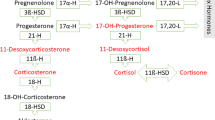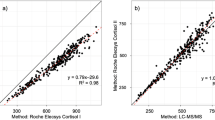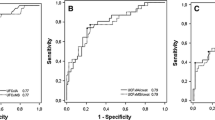Abstract
Purpose
To compare inter-laboratory and inter-assay measurements of total cortisol in patients with septic shock and to evaluate current recommendations for diagnosis of corticosteroid insufficiency in septic shock.
Methods
In the multinational CORTICUS study duplicate serum samples were taken before and after corticotropin stimulation tests in patients with septic shock. Serum cortisol was measured in paired samples, one being measured by the chemical laboratory of each participating site and the other by a central laboratory using an electrochemiluminescence immunoassay. Cortisol levels measured by tandem mass spectrometry were used as a ‘gold standard’ reference method in a subset of samples.
Results
A total of 425 corticotropin tests (850 cortisol samples) were available for comparison of local and central laboratory measurements. The concordance correlation coefficient between central laboratoty immunoassay and local hospital assays was 0.98 (CI 0.97–0.99) when the immunoassay of one manufacturer was used and 0.60 (CI 0.54–0.65) when immunoassays of different manufacturers were used. The comparison with the reference method of mass spectrometry showed concordance correlation coefficients ranging from 0.43 to 0.97 depending on the assay under study. Diagnosis of corticosteroid insufficiency was diverging due to inter-assay variations in up to 27% of cases.
Conclusion
In samples taken from patients in septic shock, there was a high inter-assay variation of total serum cortisol. Comparisons with a reference method revealed both over- and underestimations of true cortisol levels. These inter-assay variations in samples of patients with septic shock complicate the diagnosis of corticosteroid insufficiency.

Similar content being viewed by others
References
Marik PE, Pastores SM, Annane D, Meduri GU, Sprung CL, Arlt W, Keh D, Briegel J, Beishuizen A, Dimopoulou I, Tsagarakis S, Singer M, Chrousos GP, Zaloga G, Bokhari F, Vogeser M, American College of Critical Care Medicine (2008) Recommendations for the diagnosis and management of corticosteroid insufficiency in critically ill adult patients: consensus statements from an international task force by the American College of Critical Care Medicine. Crit Care Med 36:1937–1949
Cooper MS, Stewart PM (2003) Corticosteroid insufficiency in acutely ill patients. N Engl J Med 348:727–734
Cooper MS, Stewart PM (2007) Adrenal insufficiency in critical illness. J Intensive Care Med 22:348–362
Rothwell PM, Udwadia ZF, Lawler PG (1991) Cortisol response to corticotropin and survival in septic shock. Lancet 337:582–583
Annane D, Sébille V, Troché G, Raphaël JC, Gajdos P, Bellissant E (2000) A 3-level prognostic classification in septic shock based on cortisol levels and cortisol response to corticotropin. JAMA 283:1038–1045
Roberts RF, Roberts WL (2004) Performance characteristics of five automated serum cortisol immunoassays. Clin Biochem 37:489–493
Tunn S, Pappert G, Willnow P, Krieg M (1990) Multicentre evaluation of an enzyme-immunoassay for cortisol determination. J Clin Chem Clin Biochem 28:929–935
Sprung CL, Annane D, Keh D, Moreno R, Singer M, Freivogel K, Weiss YG, Benbenishty J, Kalenka A, Forst H, Laterre PF, Reinhart K, Cuthbertson BH, Payen D, Briegel J, CORTICUS Study Group (2008) Hydrocortisone therapy for patients with septic shock. N Engl J Med 358:111–124
Stroud LR, Solomon C, Shenassa E, Papandonatos G, Niaura R, Lipsitt LP, Lewinn K, Buka SL (2007) Long-term stability of maternal prenatal steroid hormones from the National Collaborative Perinatal Project: still valid after all these years. Psychoneuroendocrinology 32:140–150
Vogeser M, Briegel J, Jacob K (2001) Determination of serum cortisol by isotope-dilution liquid-chromatography electrospray ionization tandem mass spectrometry with on-line extraction. Clin Chem Lab Med 39:944–947
Brotherton J, Rothbart B (1990) Serum cortisol in adrenal hirsutism as estimated by five different methods. J Steroid Biochem 36:641–649
De Brabandere VI, Thienpont LM, Stöckl D, De Leenheer AP (1995) Three routine methods for serum cortisol evaluated by comparison with an isotope dilution gas chromatography–mass spectrometry method. Clin Chem 41:1781–1783
Cohen J, Ward G, Prins J, Jones M, Venkatesh B (2006) Variability of cortisol assays can confound the diagnosis of adrenal insufficiency in the critically ill population. Intensive Care Med 32:1901–1905
Diamandis EP (2004) Immunoassay interference: a relatively rare but still important problem. Clin Biochem 37:331–332
Azziz R, Bradley E, Huth J, Boots LR, Parker CR, Zacur HA (1990) Acute adrenocorticotropin-(1–24) (ACTH) adrenal stimulation in eumenorrheic women: reproducibility and effect of ACTH dose, subject weight, and sampling time. J Clin Endocrinol Metab 70:1273–1279
Dellinger RP, Levy MM, Carlet JM (2008) Surviving Sepsis Campaign: international guidelines for management of severe sepsis and septic shock: 2008. Intensive Care Med 34:17–60
Dellinger RP, Carlet JM, Masur H, Gerlach H, Calandra T, Cohen J, Gea-Banacloche J, Keh D, Marshall JC, Parker MM, Ramsay G, Zimmerman JL, Vincent JL, Levy MM, Surviving Sepsis Campaign Management Guidelines Committee (2004) Surviving Sepsis Campaign guidelines for management of severe sepsis and septic shock. Crit Care Med 32:858–873
Binkley N, Krueger D, Cowgill CS, Plum L, Lake E, Hansen KE, DeLuca HF, Drezner MK (2004) Assay variation confounds the diagnosis of hypovitaminosis D: a call for standardization. J Clin Endocrinol Metab 89:3152–3157
Lacey JM, Minutti CZ, Magera MJ, Tauscher AL, Casetta B, McCann M, Lymp J, Hahn SH, Rinaldo P, Matern D (2004) Improved specificity of newborn screening for congenital adrenal hyperplasia by second-tier steroid profiling using tandem mass spectrometry. Clin Chem 50:621–625
Minutti CZ, Lacey JM, Magera MJ, Hahn SH, McCann M, Schulze A, Cheillan D, Dorche C, Chace DH, Lymp JF, Zimmerman D, Rinaldo P, Matern D (2004) Steroid profiling by tandem mass spectrometry improves the positive predictive value of newborn screening for congenital adrenal hyperplasia. J Clin Endocrinol Metab 89:3687–3693
Acknowledgments
This study was supported by the European Commission contract QLK2-CT-2000-00589, the European Society of Intensive Care Medicine, and the International Sepsis Forum and the Gorham Foundation. Roche Diagnostics GmbH, Mannheim/Penzberg, Germany provided the ElecsysTM Cortisol immunoassay. The EU Commission and other sponsors had no role in the design and conduct of the study or the collection, management, analysis and interpretation of the data or in the preparation, review or approval of the manuscript.
Author information
Authors and Affiliations
Consortia
Corresponding author
Additional information
Supported by the European Commission and Roche Diagnostics.
Electronic supplementary material
Below is the link to the electronic supplementary material.
Rights and permissions
About this article
Cite this article
Briegel, J., Sprung, C.L., Annane, D. et al. Multicenter comparison of cortisol as measured by different methods in samples of patients with septic shock. Intensive Care Med 35, 2151–2156 (2009). https://doi.org/10.1007/s00134-009-1627-9
Received:
Revised:
Accepted:
Published:
Issue Date:
DOI: https://doi.org/10.1007/s00134-009-1627-9




